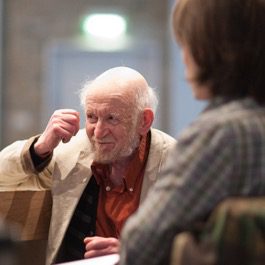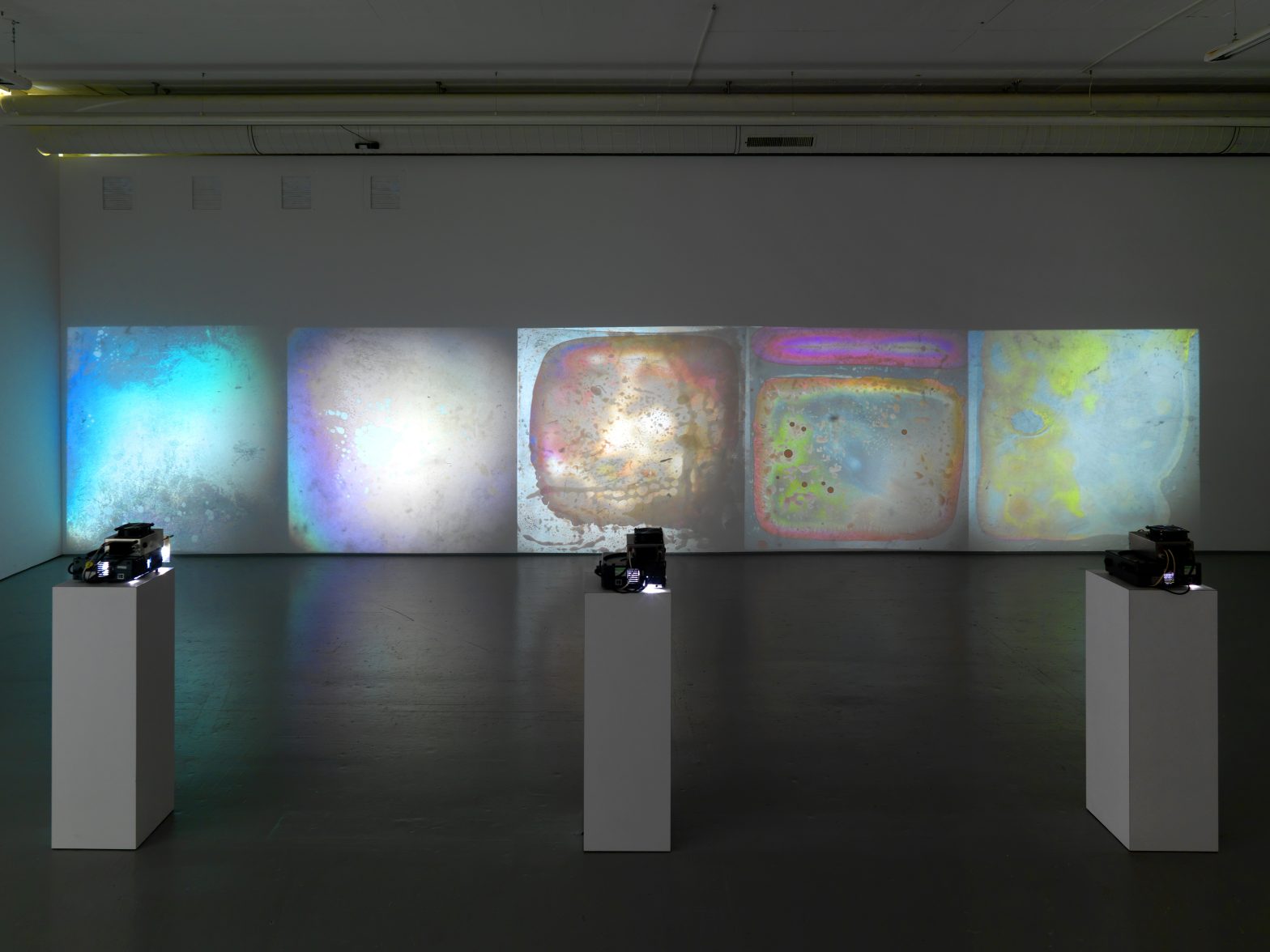Gustav Metzger’s Liquid Crystal Environments return to the gallery as part of A Moment of Grace (16 April to 10 June 2016). In this interview, he shares his insights with Emma Ridgway, Head of Programme.
–
Born in 1926 to Polish-Jewish parents in Nuremberg, Germany, Gustav Metzger is an artist known for his politically radical approach. As he explained to me a few years ago in one of our many interesting conversations, “I thought one could fuse the political idea of social change with art”. Gustav Metzger celebrates his 90th birthday on 10 April 2016. He is in good spirits and thinks as clearly and deeply as ever.
For the last 50 years, Gustav has created art that protests against the destructive drives in capitalism. He, like many, sees these inherent drives causing injustice in politics, economic relations and destruction in the environment. In the face of this reality, Gustav’s artistic response has been to devise work that has auto-destruction or auto-creation as the creative principle. That way it is the live aesthetics and social experience of art that is central for the viewer and artist – art with “inner energy towards life”.
“I remain certain that the drive towards art, the possibility of making art is of the utmost importance, and is inherently sound. … Art, I believe, needs to sink into the centre of a human being, come up, and that will be hope – the art will be hope. The art will have the energy and the wisdom out of the deep entering into oneself and into nature.”[2]

Gustav Metzger, Whitechapel Gallery on World Environment Day, London, 5 June 2009 Photograph by Benedict Johnson.
When I met with him in January 2016, I asked about his experience of Liquid Crystal Environments. As he explains, “Liquid Crystal Environments have to do with pleasure.” [2]
Emma Ridgway (ER): Your Liquid Crystal Environment combines scientific discovery with the experience of art. When creating it in the mid-sixties were there moments of surprise for you?
Gustav Metzger (GM): At the beginning, the activity of invention with liquid crystals was all surprise after surprise. It was new territory for me. To begin there was interaction with a physicist in Cambridge who was helping me. There was a lot of learning to be done. We have now got to the point where it is relatively easy to set things up and get the technical system going for the Liquid Crystal Environment.
ER: Where was the first public showing of the works and how did people experience them?
GM: The first showing of the Liquid Crystal Environment was at Better Books bookshop in the beginning of 1966. It was a year long period when I was testing and trying to show Liquid Crystal Environment. Then one evening there was a specific event that was everything to do with liquid crystal and it included a lecture by the art historian Frank Popper. It was very exciting. It was full of pleasure. Liquid Crystal Environments have to do with pleasure. Children love to be in the environment of Liquid Crystal Environment; they can go on for hours dancing in and out of the light.
ER: What is it about the work that resonates for children?
GM: First of all, it’s the light. It’s very colourful light and warmth is involved. The system itself doesn’t generate heat, but there is warmth inherently involved in the work.
ER: Please would you talk about the role of pleasure in Art?
GM: Certainly, Liquid Crystal Environment has to do with pleasure and warmth. It’s one reason I’m so heavily involved with Liquid Crystal; that is what we need. We are desperately in need of warmth as a fundamental element in human interactions. With Liquid Crystal it is physically based on warmth, it is based on the transformation of one level of warmth to another. This dialectic is central to the experience. I believe that Liquid Crystal has inherent warmth and the pleasure experience is central to it.
I support the activity to spread Liquid Crystal worldwide. It’s one of the aims of my work. For some years now I’ve had visits from a curator from Mexico who is planning to set up centres where people can experience Liquid Crystal Environment as a therapeutic experience. I believe the element of support that warmth can give people is central to the Liquid Crystal Environment. In Mexico there will be attempts to lead people to experience Liquid Crystal Environment as an ongoing basis. In other words, you can create permanent situations where you give people access to the experience.
ER: With Liquid Crystal Environment, you’ve talked in the past about nature, renewal and auto-creation. What have you observed viewers gaining from the experience?
GM: What you get is an experience of pleasure and stimulus of the changing images. Certainly the imagery is stimulating and surprise is a large part of the experience. Some people are happy to observe the changing activity over long periods of time. I think what you have with projected Liquid Crystal Environment is an ongoing field in a continuous non-stop transformation. It is potentially a very healthy experience.
So by providing the opportunity for people to experience the liquid crystal phenomena, we are enriching life as opposed to pushing it down, which tends to be the case in our kind of society. For me, Liquid Crystal Environment gives a chance to step out of mechanisation into a more vital and healthy state of affairs.
ER: Is there anything you’d like to add for Oxford visitors seeing Liquid Crystal Environment for the first time?
GM: I want people to sit or lie down, and accept what they see on the screens. It gives people the chance to have the feeling of inner warmth; the visuals are means for having deep experiences.
[1] Gustav Metzger interview with Emma Ridgway, Modern Art Oxford, January 2016
[2] Extract from Gustav Metzger interview with Emma Ridgway, RSA Arts and Ecology, April 2009
